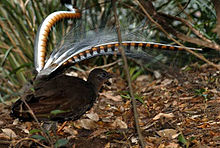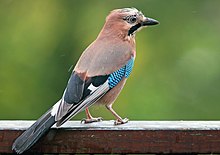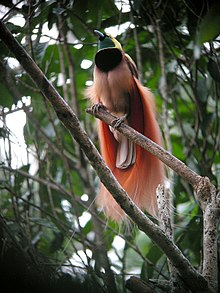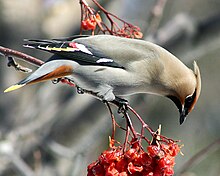Songbirds
| Songbirds | ||||||||||||
|---|---|---|---|---|---|---|---|---|---|---|---|---|

Tiger Wood Warbler ( Setophaga tigrina ) |
||||||||||||
| Systematics | ||||||||||||
|
||||||||||||
| Scientific name | ||||||||||||
| Passeri | ||||||||||||
| Linnaeus , 1758 |
The songbirds (Passeri or Oscines) are in ornithology a subordination of the passerine birds (Passeriformes). The largest of the approximately 5000 species is the common raven with a body length of over 60 cm .
Development history
Molecular phylogenetic studies and the fossil record indicate that the songbirds originated in Australia. In the Eocene originated about 33 million years ago and developed there many different ways. In the significantly colder Oligocene that followed, islands and land bridges formed due to the drop in sea level, over which the songbirds could spread further to Asia and the other continents. During this time there was a real "species explosion".
anatomy
The body of the songbird is geared towards flying and thus rapid locomotion in the air. Her physique also specializes in singing.
The skeleton is very light and yet stable. Many bones , including the strong beak , are hollow inside, so that the air sacs protrude into them . They are therefore called "pneumatized bones". The heavy body parts, especially air and leg muscles , lying close to the chest and on the spine , so that the bird in flight may very well hold the balance.
The flight muscles with their extremely active metabolism are considered to be the most efficient skeletal muscles of all vertebrates . However, a songbird converts 15 times as much energy in flight as in rest.
The lungs are about 10 times more efficient than mammals of about the same size , but also considerably smaller. Even at high altitudes, they can still take oxygen from the air . Several air sacs extend from the lungs into the abdomen between the large flight muscles and other parts of the body. The air sacs are directly or indirectly connected to the bronchi and take up to a fifth of the body volume. The Kanarengirlitz breathes by raising and lowering the breastbone. Above all, the air sacs provide cooling so that the birds' muscles do not overheat. They also serve as air reservoirs and help to equalize pressure. In addition, the specific weight of the bird is reduced by the air sacs.
The song of the songbirds is formed in the lower larynx (syrinx), where the windpipe forks into the two main bronchi. When singing, the male stretches his neck, takes a deep breath and sings with "full throat". The tones are generated by tensing the membranes and causing them to vibrate . This only works when you exhale.
The fact that canaries seem to be able to continue singing without taking a breath in between is due to the fact that they expel air quickly and swinging at a frequency of 25 Hertz . By letting the two membranes on their vocal organ, the syrinx, vibrate independently of each other, they could sing in a duet with themselves.
Sensory performances
The eyes are located on the side of the head and thus enable a very wide field of vision from 300 ° to 320 °. This enables them to perceive everything that is happening in front of them, to the side and at an angle behind them. Songbirds can distinguish colors.
Songbirds have a very strong sense of hearing. You can perceive frequencies between 1500 Hz and 29000 Hz. Some representatives of this subordination can also differentiate between very fast tone sequences, store them in memory and reproduce them. The ability of songbirds to distinguish between tones is so pronounced that they can distinguish tones that differ in height by only 0.3 percent (that is about 5 cents ). You can also recognize the direction of sound to an accuracy of around 20 °.
Songbirds have a sensitive organ of equilibrium located in the inner ear . This is important to stabilize the balance on thin branches and during flight.
The sense of smell and thus also the sense of taste are not particularly well developed, although different from species to species. They decide whether food is suitable for eating with their eyes and special tactile bodies on the edges of the beak.
Systematics
With over 90 families and around 5000 species, the songbirds are by far the most extensive taxon of birds (with the exception of higher taxa, which contain the songbirds), followed by their sister taxon , the screeching birds . Together with these and the Maori hatchers , the songbirds make up the order of the passerine birds .
The inner systematics of the songbirds was in the dark for a long time and is still in the river today. Sibley and Ahlquist published 1990 on DNA hybridization -based new bird systematics, in which they shared the songbirds into two main lines "Corvida", named after the corvids (Corvidae), and the "Passerida", according to the sparrows (Passeridae) were named, in addition, these main lines were divided by them into several superfamilies. They divided the "Corvida" into the superfamilies "Menuroidea", Meliphagoidea and Corvoidea , which, in addition to corvids , mainly contain families living in the Australo-Asian region, to which species of larger growth belong. The Passerida, which they divided into the superfamilies Muscicapoidea , Sylvioidea and Passeroidea , include songbird families with rather small-stature species such as finches, tits, thrushes and others. The Sibley-Ahlquist taxonomy was heavily criticized because of its methodological weaknesses and could not prevail, however, apart from the menuroid, the superfamilies of songbirds defined by them were retained in a different composition.
A series of phylogenetic investigations on a molecular genetic basis proved in the following years that the group of "Corvida" proposed by Sibley and Ahlquist is not a monophylum , but rather contains several families in the genealogical tree of songbirds in addition to a monophyletic nucleus. The composition of their superfamilies was only partially confirmed, including the Corvoidea, which is why more recent authors call the Corvoidea, in contrast to the original scope in Sibley and Ahlquist 1990 also 'Crown Corvoidea', only the corvids and their closest related families united, but the basic families managed separately. The Passerida, on the other hand, turned out to be monophyletic, i.e. H. A group descending from a common ancestor and containing all of his descendants.
The origin of the songbirds seems to be in the late Cretaceous period (determined with the help of the molecular clock ) in the Australian-Oceanic region, since the basal families only occur there. After Australia approached Southeast Asia as part of the continental drift , they spread northward. The passerida are the result of radiation from songbirds on the northern continents.
The Basal Australian Oceanic Families
Sibley and Ahlquist counted these families to the "Corvida" and thus to the superfamilies "Menuroidea", Meliphagoidea and Corvoidea. They are endemic to Australia, New Guinea and the nearby islands east of the Wallace Line or only with a few species beyond that. All families are relatively poor in species.
- Lyre tails (Menuridae)
- Thicket birds (Atrichornithidae)
- Bowerbirds (Ptilonorhynchidae)
- Tree slide (Climacteridae)
- Australian saber (Pomatostomidae)
- Barrel flute or barbed tail flute (Orthonychidae)
- Superfamily Meliphagoidea
- Tails (Maluridae)
- Honeyeater (Meliphagidae)
- Lackvögel (Dasyornithidae)
- Panther birds (Pardalotidae)
- South Sea Warblers (Acanthizidae)
Corvoidea
After the basal families have been separated out, the corvoid form a monophyletic unit. They are often referred to as 'Core Corvoidea' or 'Crown Corvoidea' in English-language literature.
- Superfamily Corvoidea
- Mohouidae
- Ragged plowbill (Eulacestomatidae or Eulacestomidae)
- Neosittidae
- Orioles (Oriolidae)
- Paramythiidae
- Oreoicidae
- Flöter (Cinclosomatidae)
- Great Tit's Head (Falcunculidae)
- Stubborn heads (Pachycephalidae)
- Psophodidae
- Vireos (Vireonidae)
- Cuckooshrike (Campephagidae)
- Shaft Dickkopf (Rhagologidae)
- Swallow Starlings (Artamidae)
- Flat beak (Machaerirhynchidae)
- Vangawürger (Vangidae) incl. Helmetshrike (Prionopinae) and Tephrodornithidae
- Snapper Shrike (Platysteiridae)
- Ioras (Aegithinidae)
- Wart heads (Pityriasidae)
- Bush shrike (Malaconotidae)
- Fantails (Rhipiduridae)
- Drongos (Dicruridae)
- Blue-capped flute (Ifritidae)
- Monarchs (Monarchidae)
- Shrike (Laniidae)
- Corvids (Corvidae)
- Melampittidae
- Mud nesting crows (Corcoracidae)
- Birds of Paradise (Paradisaeidae)
Passerida

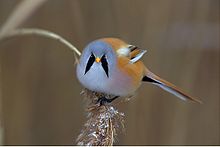
The Passerida are very likely also a monophyletic group, which is far more species-rich than all basal and Corvoidea families put together. With the exception of the oriole ( Oriolus oriolus ), the shrike and the corvids , all European songbirds belong to the Passerida family.
- Passerida
- Callaeidae (Callaeidae)
- Stinging bird (Notiomystidae)
- Berry pickers (Melanocharitidae)
- Furrow birds (Cnemophilidae)
- Rockhopper (Picathartidae)
- Fluteers (Eupetidae)
- Rock jumpers (Chaetopidae)
- Flycatcher (Petroicidae)
- Superfamily Sylvioidea
 Reed Spotter ( Donacobius atricapilla )
Reed Spotter ( Donacobius atricapilla )- Hyliotas (Hyliotidae)
- Elvencatcher (Stenostiridae)
- Titmouse (Paridae)
- Bag tits (Remizidae)
- Larks (Alaudidae)
- Bearded Tit (Panuridae)
- Drops birds (Nicatoridae)
- Macrosphenidae
- Singer are related (Cettidae)
- Cisticolidae (Cisticolidae)
- Reed warbler (Acrocephalidae)
- Dwarf Pfeifer (Pnoepygidae)
- Grass warbler (Locustellidae)
- Reed Spotter (Donacobiidae)
- Madagascar Warbler (Bernieridae)
- Swallows (Hirundinidae)
- Bulbüls (Pycnonotidae)
- Warbler-like (Phylloscopidae)
- Desert prinie (Scotocercidae)
- Tailed tits (Aegithalidae)
- Spread tails (Erythrocercidae)
- Tree Warbler (Hyliidae)
- Warblers (Sylviidae)
- Spectacled birds (Zosteropidae)
- Timalia (Timaliidae)
- Bluebirds (Pellorneidae)
- Jays (Leiothrichidae)
- Superfamily Certhioidea
 Treecreeper ( Certhia familiaris )
Treecreeper ( Certhia familiaris )- Treecreeper (Certhiidae)
- Nuthatch (Sittidae)
- Wallcreeper (Tichodromidae)
- Mosquito catcher (Polioptilidae)
- Wrens (Troglodytidae)
- Superfamily Muscicapoidea
 Gray flycatcher ( Muscicapa striata )
Gray flycatcher ( Muscicapa striata )- Dipper (Cinclidae)
- Maggot chopper (Buphagidae)
- Starlings (Sturnidae)
- Mockingbirds (Mimidae)
- Thrushes (Turdidae)
- Flycatcher (Muscicapidae)
- Superfamily Reguloidoidea
- Golden cockerel (Regulidae)
- Superfamily Bombycilloidea
- Palm talkers (Dulidae)
- Mohoidae †
- Gray Hypocolius (Hypocoliidae)
- Olivflanken-Dickkopf or Sulawesi forest Pfeifer (Hylocitreidae)
- Waxwings (Bombycillidae)
- Seidenschnäpper (Ptiliogonatidae)
- Speckled wren stimalia (Elachuridae)
- Superfamily Passeroidea
- Protea birds (Promeropidae)
- Sopranos (Modulatricidae)
- Fairy birds (Irenidae)
- Leaf birds (Chloropseidae)
- Mistletoe eater (Dicaeidae)
- Nectar birds (Nectariniidae)
- Brown cells (Prunellidae)
- Warbler (Peucedramidae)
- Rose Tail (Urocynchramidae)
- Weaver birds (Ploceidae)
- Fine finches (Estrildidae)
- Widow birds (Viduidae)
- Sparrows (Passeridae)
- Stilts and pipiters (Motacillidae)
- Finches (Fringillidae)
- Northern spur bunting and snow bunting (Calcariidae)
- Rose-breasted Tangarenammer (Rhodinocichlidae)
- Bunting (Emberizidae)
- New World Chambers (Passerellidae)
- Wren Warbler (Zeledoniidae)
- Teretistridae
- Yellow-breasted Warbler (Icteriidae)
- Starlings (Icteridae)
- Wood Warbler (Parulidae)
- Palm Tangaren (Phaenicophilidae)
- Striped head tangerines (Spindalidae)
- Nesospingidae (Nesospingidae)
- Schmätzertangaren (Calyptophilidae)
- Mitrospingidae
- Cardinals (Cardinalidae)
- Tangaren (Thraupidae)
Individual evidence
- ↑ Catalog of Life - 2019 Annual Checklist: Taxonomic Tree. Retrieved August 26, 2019 .
- ↑ FK Barker, A. Cibois et al: Phylogeny and diversification of the largest avian radiation. In: Proceedings of the National Academy of Sciences . Volume 101, Number 30, July 2004, pp. 11040-11045, doi: 10.1073 / pnas.0401892101 . PMID 15263073 , PMC 503738 (free full text).
- ↑ PG Ericson, L. Christidis et al .: A Gondwanan origin of passerine birds supported by DNA sequences of the endemic New Zealand wrens. In: Proceedings. Biological sciences. Volume 269, number 1488, February 2002, pp. 235-241, doi: 10.1098 / rspb.2001.1877 . PMID 11839192 , PMC 1690883 (free full text).
- ↑ Gerald Mayr: The age of the crown group of passerine birds and its evolutionary significance - molecular calibrations versus the fossil record. In: Systematics and Biodiversity. 11, 2013, pp. 7-13, doi: 10.1080 / 14772000.2013.765521 .
- ↑ a b R. G. Moyle, CH Oliveros et al: Tectonic collision and uplift of Wallacea triggered the global songbird radiation. In: Nature Communications . Volume 7, August 2016, p. 12709, doi: 10.1038 / ncomms12709 . PMID 27575437 , PMC 5013600 (free full text).
- ^ Judith Hartl: All songbirds are Aussies - knowledge & environment. In: dw.com. August 30, 2016. Retrieved October 26, 2016 .
- ↑ a b C. G. Sibley, JE Ahlquist: Phylogeny and classification of birds . Yale University Press, New Haven, Conn 1990, ISBN 0-300-04085-7 .
- ^ KA Jønsson, J. Fjeldså: A phylogenetic supertree of oscine passerine birds (Aves: Passeri) . In: Zoologica Scripta . tape 35 , 2006, pp. 149–186 , doi : 10.1111 / j.1463-6409.2006.00221.x ( researchgate.net [PDF; accessed October 20, 2015]).
- ↑ a b Janet L. Gardner, John WHTrueman, Daniel Ebert, Leo Joseph and Robert D. Magratha: Phylogeny and evolution of the Meliphagoidea, the largest radiation of Australasian songbirds . In: Molecular Phylogenetics and Evolution . June 2010, doi : 10.1016 / j.ympev.2010.02.005 , PMID 20152917 .
- ↑ Silke Fregin, Martin Haase, Urban Olsson, Per Alström: New insights into family relationships within the avian superfamily Sylvioidea (Passeriformes) based on seven molecular markers. In: BMC Evolutionary Biology. 12 (1), 157, 2012, pp. 1-12.
- ↑ Gerald Mayr: A previously unnoticed vascular trait of the middle ear suggests that a cranial heat-exchange structure contributed to the radiation of cold-adapted songbirds. In: Journal of Ornithology. Vol. 160, No. 1, 2019, pp. 173-184, doi: 10.1007 / s10336-018-1588-2 .
- ^ A b F. Keith Barker, George F. Barrowclough, Jeff G. Groth: A phylogenetic hypothesis for passerine birds: taxonomic and biogeographic implications of an analysis of nuclear DNA sequence data. In: Proc. R. Soc. Lond. B, 2002. PMC 1690884 (free full text)
- ^ A b F. Keith Barker, Alice Cibois, Peter Schikler, Julie Feinstein, Joel Cracraft: Phylogeny and diversification of the largest avian radiation. In: PNAS. Vol. 101, no.30, July 27, 2004. (PDF)
- ↑ P. Beresford, FK Barker, PG Ryan, TM Crowe: African endemics span the tree of songbirds (Passeri): Molecular systematics of several evolutionary "enigmas". In: Proc. R. Soc. Lond. B 272, 2005, pp. 849-858. (PDF)
- ↑ PGP Ericson, L. Christidis, M. Irestedt, JA Norman: Systematic affinities of the lyrebirds (Passeriformes: Menura), with a novel classification of the major groups of passerine birds. In: Mol. Phylogen. Evol. 25, 2002, pp. 53-62 (PDF)
- ↑ PGP Ericson, L. Christidis, A. Cooper, M. Irestedt, J. Jackson, US Johansson, JA Norman: A Gondwanan origin of passerine birds supported by DNA sequences of the endemic New Zealand wrens. In: Proceedings of the Royal Society of London. Series B, 269, 2002, pp. 235-241. PMC 1690883 (free full text)
- ↑ a b c d e f g h David W. Winkler, Shawn M. Billerman, Irby J. Lovette: Bird Families of the World - An Invitation to the Spectacular Diversity of Birds. Lynx Edicions and the Cornell Lab of Ornithology, 2015, ISBN 978-84-941892-0-3 . Page 10 and 11.
literature
- Jürgen Nicolai , Einhard Bezzel : Songbirds. Identify, get to know and protect the most important species in Europe . Gräfe and Unzer, Munich 1999, ISBN 3-7742-3159-1 .
- John PS Mackenzie: Birds of the World: Songbirds . Parkland, Cologne 1997, ISBN 3-88059-874-6 .
- Konrad EA Kleinschmidt: The songbirds of home. 1921. (full text online)
Web links
- John Harshman: Oscines. Songbirds. Version July 31, 2006. in The Tree of Life Web Project
